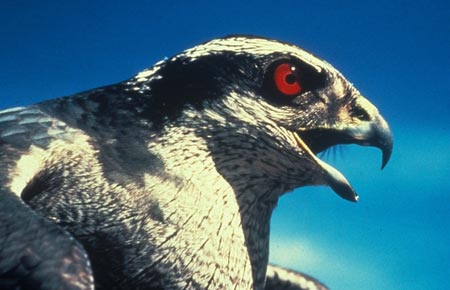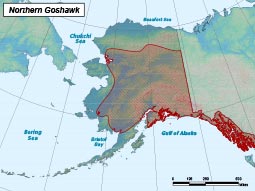Northern Goshawk
(Accipiter gentilis)
Species Profile
Did You Know?
The hawks' short, broad wings enable them to accelerate rapidly, and their long tails are efficient rudders for steering around trees.
General Description
Adult northern goshawks are bluish-gray on the back, wings, and tail, and pearly gray on the breast and underparts. The dark gray cap is accented by a light gray stripe above the red eye. Like most birds of prey, female goshawks are larger than males. A typical female is 25 inches (65 cm) long, has a wingspread of 45 inches (115 cm) and weighs two and a quarter pounds (1020 g) while the average male is 19 1/2 inches (50 cm) in length with a wingspread of 39 inches (100 cm) and weighs two pounds (880 g).
Immature birds are brown on the back, wings and tail, with buff-colored underparts streaked with brown. The eyes of young accipiters are yellow; it takes several years for them to change to the red of adults. Young goshawks have a buff eyestripe and the long tail is broadly banded with dark gray in adults and dark brown in immature goshawks. The tail is tipped with white in adults and buff in immature goshawks.
Life History
Growth and Reproduction
Northern goshawks build large stick nests, usually in a major crotch of birch or aspen trees. Nesting usually begins in early to mid-April, often when there is still snow on the ground. The area immediately surrounding the nest is vigorously defended against intruders — the adults scream and dive at interlopers, slashing and grabbing at the offenders with their feet.
Northern goshawks display a monogamous mating system. Mating pairs will bond for life, only seeking out a new mate upon the death of the previous one. Goshawks lay one to four eggs, with three or four being the most common clutch sizes. Young goshawks hatch in late May or early June, grow quickly, and fledge in early to mid-July. The young birds remain in the vicinity of the nest as they develop their powers of flight and sharpen their hunting skills. The parents continue to feed their offspring for as long as the young birds remain in the area, often until early August.
Feeding Ecology
Accipiters are adept at flying quickly through dense woods in search of their favored prey. The hawks' short, broad wings enable them to accelerate rapidly, and their long tails are efficient rudders for steering around trees. The birds employ this ability to negotiate wooded habitats in hunting. They perch quietly in trees or move stealthily from perch to perch. When prey is sighted, they make a rapid dash after it. If the intended prey is not caught quickly, the pursuit is dropped after a short distance. When the hawks do get close, they reach out with their long legs and grab the animal with powerful, taloned feet.
Goshawks have tremendously strong feet and legs and are capable of subduing large prey, such as snowshoe hares, grouse, ptarmigan, and ducks. They also eat squirrels, voles, shrews, and some of the larger songbirds and shorebirds. Typically, a few feathers or tufts of fur are ingested with each meal. These, along with bones and fragments of insect exoskeleton, are not digested but are bundled into compact "pellets" and regurgitated. Pellets can often be found among prey remains near the birds' favorite perches (accipiters usually take their kills to "plucking perches" or "butcher blocks" where they pull out the feathers or fur of prey before eating it). Pellets and other remains provide biologists with valuable clues to the hawks' diets.
Migration
Northern goshawks do not make long-distance migrations and can be found year-round throughout their range in Alaska. Some may migrate locally to lower elevations during cold winter months.
Range and Habitat
Northern goshawks are found in most mountainous and forested habitats of North America, ranging from western central Alaska down into the mountains of northwestern and western Mexico.
While accipiters can and do exploit a variety of habitats for hunting, they prefer to nest in mixed stands of coniferous and deciduous trees. They often return to the same general area in successive years and will occasionally reuse an old nest.
Status, Trends, and Threats
Status
- NatureServe: G5
- IUCN: LC (Least Concern)
Threats
Because young accipiters usually weigh less than their parents and have slightly longer flight feathers, their wing loading is lower (i.e., less weight distributed over a large wing area). This enables young birds to fly slower and more buoyantly than adults, but they still occasionally fall victim to their own clumsiness and fatally miscalculate a landing. A large number of birds succumb to other hazards, including disease, predation, flying into windows, being shot by humans, and being struck by vehicles. Goshawks also fall victim to the weather; birds which are barely able to catch enough food to stay alive in warm weather don't survive for long when cold weather increases the food intake requirements. As many as 80 to 90 percent of birds die during their first winter.
Northern goshawks have few enemies in the wild other than the elements. They are rarely caught in a position where they are unable to either defend themselves or evade their attacker. They are most vulnerable when the female is incubating eggs or brooding small nestlings and when the young are first learning to fly. At these times, other large hawks or owls occasionally kill goshawks; and bears, lynx, and other climbing predators sometimes reach nests and eat young birds. Although many goshawks are killed in the name of defense of poultry or other small livestock, only a few birds actually deserve the title, "chicken hawk."
Fast Facts
-
Size
Weight: 631 to 1364 g
Length: 55 to 61 cm
Wingspan: 98 to 115 cm -
Lifespan
11 years -
Range/Distribution
Mountainous, forested regions of western central Alaska, continuing southeast into the Yukon and southeast Alaska. -
Diet
Snowshoe hares, grouse, ptarmigan, ducks, squirrels, voles, shrews, and some of the larger songbirds and shorebirds. -
Predators
Great horned owls, hawks and eagles, martens, eagle owls, bears, lynx, and wolves -
Reproduction
Monogamous, breeding once per year in the early to mid-April. Females lay 1–4 eggs, which hatch in late May. -
Remarks
Preservation of Alaska's raptors depends on research and habitat protection. Increased knowledge and preservation of critical habitat will help perpetuate the woodland hawks of Alaska.


